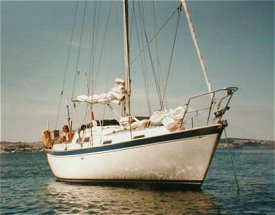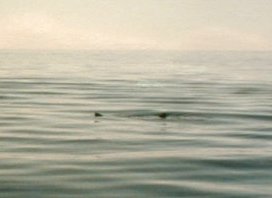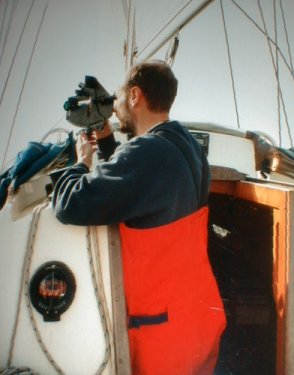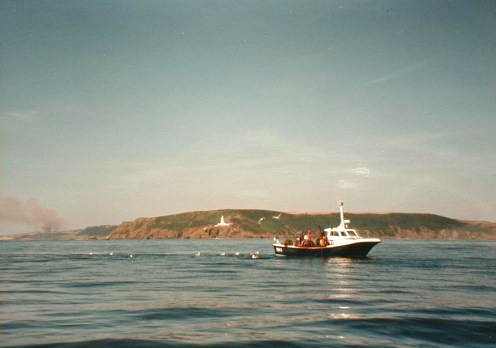

Brixham is an ancient port and anchorage well sheltered from prevailing Westerlies by Start Point and twelve more miles of east-facing coast. It is then further tucked within Tor Bay, and also has a long, Victorian breakwater to protect it from any Easterly swell or weather. Since the dawn of time seafarers will have used it. Brixham trawlers of the nineteenth century were powerful gaff-rigged vessels, famous for their strength and performance all around Britain's coasts, in any weather. Today a good fleet of steel motor-trawlers operate from here and their catches are sold all over the country.
I had sailed into Brixham several times from the islands, before I met Nicky. I remember one of these long single-handed crossings ending at about 03:00am with me decidedly glad to be there. I had felt very sick for hours in a force 6 - 7 in the open channel. The 'chop' that this kicks up can be 10 ft high (3m) and very steep when you have wind against tide - which you inevitably do for six hours out of every twelve. The sails furled, the safe-water entrance buoy found and senses straining I nosed my way in between the local boats on their moorings toward the marina pontoons.
Almost as soon as I made out the rows of sleeping yachts I also saw a light moving about among them. Next thing this torch was swinging back and forth rhythmically and clearly directed at me. What did that mean? Does it mean 'Come Here' or 'Stay Away'? I am sure that I have it in a book down below somewhere... but I could not leave the tiller now to go rummaging in books!
I continued regardless and tried to do what I would normally do when looking for a berth. In due course an empty space showed up and the man with the torch was there to take my lines and help me tie up. I thanked him kindly and we chatted.
"Why didn't you come in where I was signalling? Much bigger space down there," he began.
"Oh, this'll do me fine," I countered.
"Good trip?" he asked. It turned out that was he was a fellow yachtsman who couldn't sleep and was out for a walk when he saw my lights approaching.
"Great now it's over!" I told him about the mal-de-mer. At least he didn't show astonishment, like many do, that a sufferer from motion-sickness would ever want to sail anywhere. Given enough bouncing, anyone will succumb eventually.
"What do you use?" he asked.
"Nothing," I told him. I was trying to get over the problem by shear force of will. I also could not risk the drowsiness which is a side effect of most preventatives and cures, not when single-handed in shipping lanes.
After a while he went back to his own boat, nearly opposite mine, and I went to bed. I slept happily through the morning and didn't open the hatch-boards until lunch time. When I did, a small, white cardboard packet fell in, onto the steps. It contained Scopaderm, a sea-sickness preventative contained in patches which you apply behind your ear. At the time these were the latest technology and only available in America. I don't know where he got them or what generosity had spurred him to give them to me. His boat was gone and there was no not. The patches were out of date and I never used them as I worried about side effects. These days I take Stugeron tablets before and during a rough crossing. Nicky would wake me up if they put me to sleep at the wrong time, but actually they seem to work ok.
 |
| A lazy day at anchor in Fishcombe Cove, near Brixham |
During this stay in Brixham, we stuffed ourselves with the local delicacy - fish and chips - and had a few nice day-sails in Tor Bay. We anchored one hot day in Fishcombe Cove, a tiny bay just outside the main harbour. On the last night, after a visit to the local yacht-club, we had permission to use the very cheap pontoon below the club-house so we left the marina and moved across.
It wasn't until about 04:00 that we we found out why this little pontoon was so cheap and so empty. We were even closer to the trawler's fish-unloading quay than to the yacht club. With the dawn, a fresh catch brought in about a million sea-gulls, or so it seemed! The noise was astonishing. All hope of going back to sleep was forgotten and we were soon getting ready for an early start!
By 08:00 we were motor-sailing around the end of the breakwater in a flat calm. We were going south around Start Point then west to Salcombe, some 25 miles away.
 |
| Basking Shark! |
As we approached Start Point at about 10:00, Nicky noticed two dark triangles in the oily sea away to starboard. Through binoculars the front one looked like a shark's fin alright, but we had never seen the second, smaller one behind in any Jaws film. Was it a baby following a mother?
Within seconds we saw another pair of fins dead ahead, and much closer. I reached for the throttle, but it was too late - we were upon it - or them. With one lazy flick of its huge body the single, black animal dived just enough to let us pass over it. We clearly saw two rows of wide open gill-slits on one side of the cockpit and plenty of tapering body the other. The shark was at least 20 feet long with a girth of 3 feet or more. We were struck by a kind of lazy arrogance in its sinuous movement, and minimal effort to let us pass through its bit of sea. This close encounter happened too quickly for us to get a photograph, but within 10 minutes we had seen a total of five of these magnificent beasts.

|
| Using the plastic sextant to take a conventional sun-sight |
They were basking sharks. They feed by filtering the microscopic plankton from the vast quantities of sea water that passes through those gills. They are quite harmless to us and a real treat to see at such close quarters.
A sextant is a wonderful optical instrument for measuring angles to extreme accuracy. You look through a telescope and see two images, either superimposed or side-by-side depending on your mirror design. One is the view straight ahead and the other has been diverted by mirrors, it is actually off at some other angle. The exact angle you can change and its precise value can be read from a scale on the curved bottom of the instrument. When you make the images of any two objects coincide exactly, you can read the angle between them from the scale very accurately.
A superb sextant can cost thousands of pounds, a good one hundreds. I have a plastic one that cost about £25, but it works ok. You just mustn't squeeze the handle too hard or you can see the images move around, then you can set them anywhere you want! Obviously you mustn't squeeze it!
The normal marine use of a sextant is to find the angle between the horizon and the sun, the moon, a planet or a star. You 'bring it down' until the heavenly body's image sits neatly on the image of the horizon. Complex calculations then, eventually, give you your position at sea. I have done this and even my plastic sextant gives a position accurate to 5 - 10 miles. Luckily, modern electronics, while it works, does much better than this and so this is a very deep back-up.

|
| Passing a local fisherman as we round Start Point |
As we rounded Start Point this sunny July morning, after the excitement of the sharks had died down, I decided to give the sextant an airing to guide our route. The lantern on Start Point Light House was 64.5m above the sea (Height of tide was 2.5m above datum) so when the angle between the lantern and the water's edge was 1° 00'.4 then we were 1.9 NM off. Later, the angle increased to 1° 37'.5 because we had come in to 1.2 NM off. By steering to control this angle between one and one-and-a-half degrees for 35 minutes, we were able to 'handrail' around the light safely between one and two miles off it. This was satisfying to do, and it helps pass the time in calm weather. Practice at skills like this could come in handy, we are told, if everything goes horribly wrong one day.